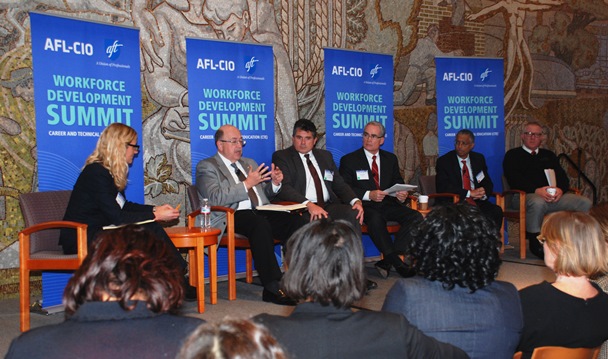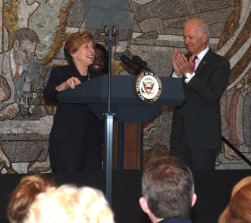 |
| IAM International President Tom Buffenbarger, second from left, joins labor and business leaders on a panel on how best to match people to jobs in the new economy during the Career and Technical Education/Workforce Development Summit in Washington, DC. |
The U.S. is facing a major skills gap and it’s up to labor, business and the education community to come together to address it, said IAM International President Tom Buffenbarger at a recent summit on Career and Technical Education (CTE)/Workforce Development, sponsored by the AFL-CIO and the American Federation of Teachers (AFT).
The one-day summit, attended by Vice President Joe Biden and Labor Secretary Tom Perez, focused on how career and technical education can prepare students for college and the workforce. It also emphasized the role of unions in partnering with communities, policymakers and businesses to jumpstart economic development.
 |
| American Federation of Teachers President Randi Weingarten, left, joins Toledo Technology Academy graduate Alexis Smith, center, in introducing Vice President Joe Biden as keynote to the Career and Technical Education/Workforce Development Summit in Washington, DC. |
“What we’re seeing in our union is the movement of the Baby Boomers. They can see the exit door now. And there’s a gap in the amount of workers we’re going to need and the type of training in skills that are going to be required,” said Buffenbarger to the group of 150 business leaders, educators, labor representatives and government officials. “We need the help of the business community, and more importantly the help of the education community, to explain to young people there’s another great avenue to making a great living and having a high-quality job, with a great deal of satisfaction for what you do, by coming into the skilled trades.”
Buffenbarger, while speaking on a panel on “How to Navigate the New Economy: Matching People to Jobs,” touted the IAM’s current partnerships and joint training programs at Goodwin College in Connecticut, the IAM/Boeing Joint Apprenticeship Program in Seattle, the union’s automotive apprenticeship programs in Chicago, New York, St. Louis and San Francisco, as well as current labor-management partnerships with the Tennessee Valley Authority and Spirit AeroSystems in Wichita, KS.
“These partnerships provide a seamless transition so folks can go from a classroom to a job, and from job-to-job within the industry they’re in,” said Biden, a keynote speaker at the summit. “Unions have been doing this their entire existence. Organized labor has been responsible for the United States becoming the greatest economic power in the 20th century and will remain so in the 21st century. You’ve all helped build the middle class and we’ve got a job of rebuilding it.”
AFL-CIO Secretary-Treasurer Elizabeth Shuler said workforce development is a fundamental part of America’s infrastructure. “It’s as basic to our economy and our communities as building roads and bridges,” said Shuler. “In fact, workforce development is a bridge—a bridge to our future, to the workers, jobs and technology of tomorrow, to our success as individuals and industries and to our competitiveness as a nation.”
“When you invest in your talent, when you invest in your students, when you create pathways of equal stature, then you can really build and take this to scale,” said Perez. “And you can really build those pathways to shared prosperity.”
Other speakers included AFL-CIO President Rich Trumka, AFT President Randi Weingarten, North America’s Building Trades Union President Sean McGarvey, National Electrical Contractors Association Vice President of Labor Relations Geary Higgins, United Technologies Propulsion and Aerospace Systems Vice President Terry Nolan, Snap-on Tools Chairman/CEO Nicholas Pinchuk, and teachers and graduates from exemplary trade and technical high schools around the country.